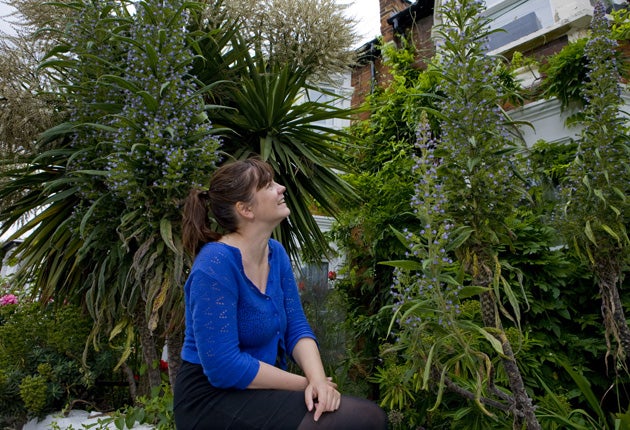Eyes front! Treat your neighbours to a crowd-stopping front garden
Emma Townshend has the perfect plan to catch the eye of passers-by – and nothing will stop them in their tracks quite like an array of plants from foreign climes

Earlier this year there was an apologetic, quiet knock on my front door. "I'm sorry to disturb you," said the slightly frazzled-looking lady on the doorstep, "you don't actually know me or anything, it's just that I always admire the plants in your front garden, and I was wondering, I've been meaning to stop and ask for quite a few years, what on earth is that blue thing?"
That blue thing is Echium pininana, a garden plant as reimagined by Norman Foster to provide a 2m-tall skyscraper for bees. On hot afternoons, you can actually "hear" the plant it's often so full of them.
It wasn't the first time someone has summoned up the courage to ask for plant information on what's growing out the front round at mine. "I recognise that from when I was growing up, but what is it?" asked a smartly dressed man, stopping on his walk home from work early one evening. It turned out he had grown up in St Lucia; the plants in question were cannas, with huge, banana-like leaves.
For me, the big, tall, eye-catching plants that really make a front garden mostly come from far away, but not necessarily exotic, climes. At the moment, a cordyline is perfuming most of our end of the street with clouds of tiny, creamy, star-shaped flowers – though at home, it's just a humble New Zealand Cabbage Palm.
The stately blue towers of Echium pininana are themselves native to the dry, rocky shores of the Canary Islands – not most people's definition of an "exotic" destination. Echiums came to English gardening first in the Scillies, where they slowly colonised the lanes and front gardens near the famous Abbey Gardens on Tresco. Then visiting Cornish gardeners fancied growing it, and this spectacular tourist happily jumped to the mainland. Finally, of course, emmet Londoners such as, ahem, me, fell in love with it and took home seedlings (or, in my case, packets of seed). It turns out that this echium grows very well like this, reseeding itself every year in the early months if you let the seed scatter from the dying flowerhead.
It's a biennial, which means it is sown one year, grows to about a 4ft plant during that growing season, then must survive till the next spring if it is to produce a traffic-stopping bloom. When echiums were first grown in the UK, an awful lot of bubble wrap was involved, the plants being carefully covered come October.
However, with every passing winter, we enthusiasts realise the cosseting is less necessary than we'd imagined. This year, my yearling echiums survived all the snow and ice episodes the winter could muster with the occasional help of a few black bin bags. Once they find a happy, sunny spot, they are away. In fact, the only thing you really have to worry about is the fairly allergenic hairs that cover every leaf: this is definitely a plant to handle with care. Then just be sure to mind the bees.
Three crowd-stoppers
Cabbage Palm
An unprepossessing yucca-alike to start with, this comes into its own at about the 10-year marker, when it will flower its little Cath Kidston floral socks off planted in the right position.
Save time by buying a specimen plant, £35, burncoose.co.uk
'Echium pininana'
These need to be established as small plants in a hot spot. Buy three to ensure at least one makes it through the winter.
3-litre plant, £8.50, burncoose.co.uk, or 10 seeds for £2.68, jungleseeds.co.uk
Canna 'Wyoming'
A truly red parrot of a flower with dark burgundy leaves, to make everyone feel as though they're in the Caribbean. Or at least on a roundabout in the South of France. £7 each, burncoose.co.uk
Join our commenting forum
Join thought-provoking conversations, follow other Independent readers and see their replies
Comments
Bookmark popover
Removed from bookmarks